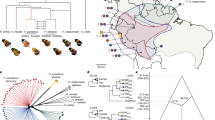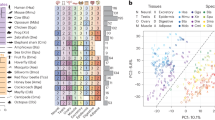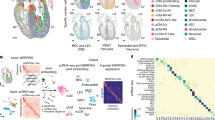Abstract
Homozygous diploid zebra fish have been produced on a large scale by the application of simple physical treatments. Clones of homozygous fish have been produced from individual homozygotes. These clones and associated genetic methods mil facilitate genetic analyses of this vertebrate.
This is a preview of subscription content, access via your institution
Access options
Subscribe to this journal
Receive 51 print issues and online access
$199.00 per year
only $3.90 per issue
Buy this article
- Purchase on Springer Link
- Instant access to full article PDF
Prices may be subject to local taxes which are calculated during checkout
Similar content being viewed by others
References
Benzer, S. Proc. natn. Acad, Sci. U.S.A. 58, 1112–1119 (1967).
Brenner, S. Genetics 77, 71–94 (1974).
Hamilton, F. Account of the Fishes Found in the River Ganges and its Branches (Edinburgh, (1822).
Buchanan, F. Rev. Bull. Gen. Universel (Fereissac) 3, 253 (1823).
Laale, H. W. J. Fish. Biol. 10, 121–173 (1977).
Schirone, R. C. & Gross, L. J. exp. Zool. 169, 43–52 (1968).
Hoppe, P. C. & Illmensee, K. Proc. natn. Acad. Sci U.S.A. 74, 5657–5661 (1977).
Markert, C. L. & Petters, R. M. J. exp. Zool. 201, 295–302 (1977).
Nace, G. W., Richards, C. M. & Asher, J. H. Jr Genetics 66, 349–368 (1970).
Hertwig, G. Arch, mikrosk. Anat. EntwMech. 77, 165–209 (1911).
Fankhauser, G. J. Hered. 28, 3–15 (1937).
Subtelny, S. J. exp. Zool. 139, 263–305 (1958).
Tilney, L. G., Hiramoto, Y. & Marsland, D. J. Cell Biol. 29, 77–95 (1966).
Marsland, D. Int. Rev. Cytol. 5, 199–227 (1956).
Dasgupta, S. J. exp. Zool. 151, 105–121 (1962).
Swann, M. M. Expl Cell Res. 7, 505–517 (1954).
Endo, A. & Ingalls, T. H. J. Hered. 59, 382–384 (1968).
Brewer, E. N. & Rusch, H. P. Expl Cell. Res. 49, 79–86 (1968).
Fankhauser, G. & Watson, R. C. Proc. natn. Acad. Sci. U.S.A. 28, 436–440 (1942).
Swarup, H. J. Genet. 56, 129–142 (1959).
Purdom, C. E. Heredity 29, 11–24 (1972).
Fischberg, M. J. Embryol. exp. Morph. 6, 393–402 (1958).
Holmes, R. S. & Whitt, G. S. Biochem. Genet. 4, 471–480 (1970).
Hart, N. H. & Cook, M. Comp. Biochem. Physiol. B54, 357–364 (1976).
Lindsley, D. L., Fankhauser, G. & Humphrey, R. R. Genetics 41, 58–66 (1956).
Volpe, E. P. & Dasgupta, S. J. exp. Zool. 151, 287–301 (1962).
Yamamoto, T. in Fish Physiology Vol. 3 (eds Hoar, W. S. & Randall, D. J.) 117–175 (Academic, New York, (1969).
Sinnhuber, R. O., Hendricks, J. D., Wales, J. H. & Putnam, G. B. Ann. N. Y. Acad. Sci. 298, 389–408 (1977).
Gordon, M. in The Care and Breeding of Laboratory Animals (ed. Farris, E.) 345–449 (Wiley, New York, (1950).
Kligerman, A. D. & Bloom, S. E. J. Fish. Res. Bd. Can. 34, 266–269 (1977).
Scheel, J. J. Z. zool. Syst. Evolut.-forsch. 10, 180–209 (1972).
Shaw, C. R. & Prasad, R. Biochem. Genet. 4, 297–320 (1970).
Author information
Authors and Affiliations
Rights and permissions
About this article
Cite this article
Streisinger, G., Walker, C., Dower, N. et al. Production of clones of homozygous diploid zebra fish (Brachydanio rerio). Nature 291, 293–296 (1981). https://doi.org/10.1038/291293a0
Received:
Accepted:
Issue Date:
DOI: https://doi.org/10.1038/291293a0
This article is cited by
-
Establishment of a zebrafish inbred strain, M-AB, capable of regular breeding and genetic manipulation
Scientific Reports (2024)
-
Hybridization barriers between the congeneric antarctic notothenioid fish Notothenia coriiceps and Notothenia rossii
Polar Biology (2024)
-
Pharmacological effects of caffeine on ventilation in adult zebrafish under free-swimming conditions
Scientific Reports (2022)
-
Hippo-Yap/Taz signalling in zebrafish regeneration
npj Regenerative Medicine (2022)
-
The Zebrafish model in dermatology: an update for clinicians
Discover Oncology (2022)
Comments
By submitting a comment you agree to abide by our Terms and Community Guidelines. If you find something abusive or that does not comply with our terms or guidelines please flag it as inappropriate.



